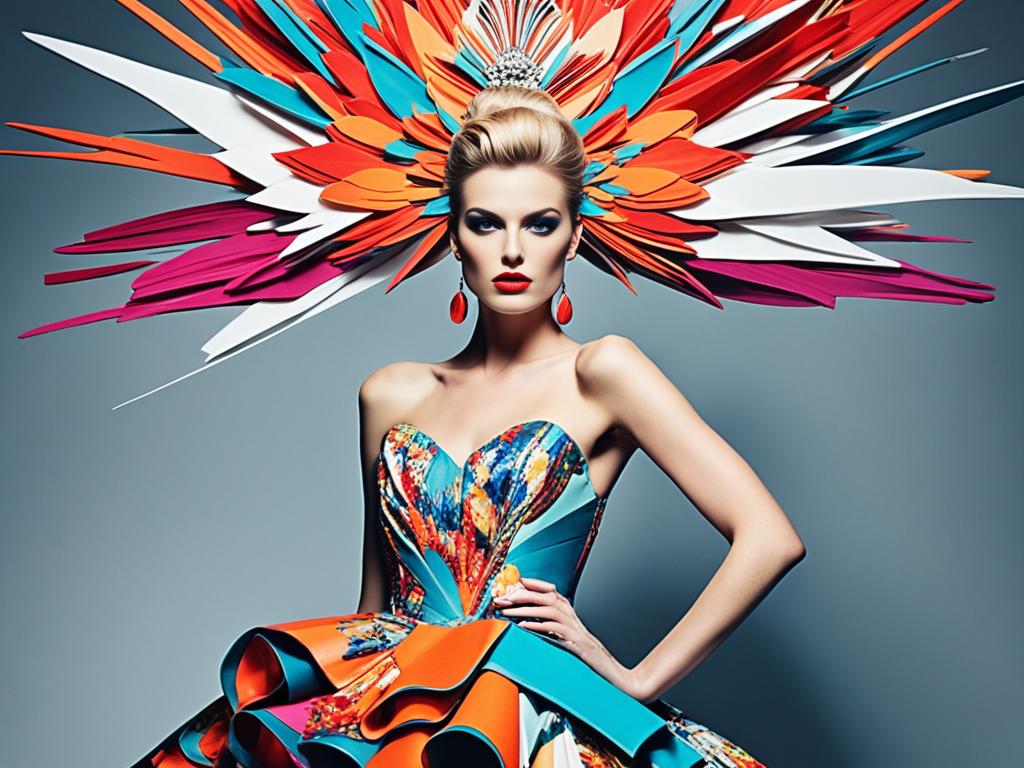Welcome to a world where fashion transcends its traditional boundaries, merging with the realm of art. From the runway to the canvas, fashion has become a captivating form of self-expression, blurring the lines between couture and culture. This fusion of creativity and style has reshaped our perception of both fashion and art, creating a vibrant and dynamic space where innovation thrives.
As fashion designers push the boundaries, experimenting with unconventional materials, bold silhouettes, and captivating patterns, the line between fashion and art becomes increasingly blurred. The runway transforms into a canvas, where garments are masterpieces, and the body is a living work of art.
This artistic approach to fashion is not limited to high-end couture. It also extends to the world of popular culture, where fashion becomes a reflection of societal movements, music, movies, and the influence of our favorite fashion icons. From streetwear to red carpet glamour, fashion becomes a tangible expression of individuality and a medium for cultural storytelling.
However, fashion as art is not just about aesthetics—it also embraces sustainability and ethical practices. As designers strive to merge creativity with conscious choices, they adopt an artistic approach to sustainability. Through the use of eco-friendly materials, upcycling, and ethical production processes, fashion becomes a vehicle for change, highlighting the importance of responsible choices and environmental stewardship.
Furthermore, technology has revolutionized the fashion industry, ushering in a new era of digital artistry. From digital design tools that enable endless creativity to wearable tech that merges functionality with style, technology has opened up exciting possibilities that bridge the gap between fashion and innovation.
At the heart of this fusion of couture and culture lies an exploration of diverse traditions, heritage, and global perspectives. Fashion draws inspiration from cultural influences, embracing the richness and uniqueness of different societies. It becomes a powerful tool for celebrating diversity and challenging stereotypes, creating a global tapestry of style and self-expression.
Key Takeaways:
- Fashion as art blurs the boundaries between couture and culture, merging creativity and self-expression.
- Fashion designers are pioneers in the fusion of fashion and art, pushing boundaries with innovative designs.
- Fashion’s relationship with popular culture influences trends, incorporating influences from music, movies, and celebrity fashion icons.
- The artistic approach to fashion embraces sustainability and ethical practices as a medium for change.
- Technology has transformed fashion with digital tools, innovative materials, and wearable tech.
Pioneers of Fashion as Art
When it comes to fashion as art, there have been pioneering designers who have fearlessly pushed the boundaries of creativity, elevating fashion to a form of self-expression and artistic excellence.
One of the most notable pioneers in the realm of fashion as art is Yves Saint Laurent. With his avant-garde designs and innovative approach, Saint Laurent revolutionized the industry, transforming garments into exquisite works of art. His ability to blend fashion and artistic expression created a new paradigm that continues to inspire designers today.
Another trailblazer in the world of fashion as art is Alexander McQueen. Known for his theatrical runway shows and boundary-pushing designs, McQueen pushed the limits of artistic expression through fashion. His unique blend of craftsmanship and storytelling cemented his legacy as one of the greatest fashion artists of our time.
“Fashion should be a form of escapism, and not a form of imprisonment.” – Alexander McQueen
The renowned Vivienne Westwood is also recognized as a pioneer in merging fashion and art. Known for her rebellious and provocative designs, Westwood challenged societal norms, using fashion as a medium for political and cultural commentary. Her innovative creations continue to inspire designers seeking to make bold statements through their work.
These creative visionaries are just a few examples of the fashion designers who have blurred the lines between art and couture. Through their groundbreaking designs and artistic expressions, they have paved the way for a new era in fashion, where self-expression and creativity reign supreme.
Pioneers of Fashion as Art:
| Fashion Designer | Notable Contributions |
|---|---|
| Yves Saint Laurent | Revolutionized fashion with avant-garde designs and artistic expression |
| Alexander McQueen | Pushed boundaries with theatrical shows and captivating storytelling |
| Vivienne Westwood | Merged fashion, art, and political commentary through rebellious designs |
The influence of these pioneers is undeniable, and their impact on the fashion industry continues to resonate. They have paved the way for a new generation of designers to explore the artistic possibilities within fashion, blurring the lines between couture and canvas.
High Fashion and Popular Culture: A Symbiotic Relationship
When it comes to high fashion and popular culture, there exists a symbiotic relationship that has a profound impact on both worlds. Fashion trends and styles are not created in a vacuum; they are heavily influenced by the ever-evolving landscape of cultural movements, music, movies, and the iconic fashion choices of celebrities. This dynamic interplay between high fashion and popular culture shapes our collective sense of style and self-expression, blurring the lines between runway and reality.
Popular culture has always been a driving force behind fashion. From the rebellious spirit of the 1960s counterculture influencing the rise of bohemian fashion to the streetwear revolution ignited by hip-hop culture, cultural movements have sparked trends that eventually trickle up into the high fashion realm. The impact is undeniable, as designers draw inspiration from the streets, music scenes, and subcultures that shape the cultural zeitgeist.
“Fashion is not something that exists in dresses only. Fashion is in the sky, in the street; fashion has to do with ideas, the way we live, what is happening.”
Music and movies have also played pivotal roles in the symbiotic relationship between high fashion and popular culture. The costumes worn by musicians on stage and in music videos can quickly become fashion statements, influencing not only fans but also designers. Similarly, films have the power to catapult particular styles or aesthetics into the spotlight, immortalizing them in our collective consciousness.
To truly appreciate the symbiotic relationship between high fashion and popular culture, we need only look to the influence of celebrity fashion icons. From Audrey Hepburn’s timeless elegance to Lady Gaga’s avant-garde fashion choices, celebrities have the ability to shape trends and redefine what is considered fashionable. The red carpets of award shows and premieres become runways in their own right, showcasing the latest haute couture designs that will inevitably filter down into the mainstream.
The symbiotic relationship between high fashion and popular culture is beautifully complex. It is a constant dialogue between artistic expression and societal influences, shaping our fashion choices and redefining the boundaries of style. As fashion continues to evolve and push the envelope, it will undoubtedly draw inspiration from the ever-changing tapestry of popular culture, cementing its position as a form of art that reflects and influences the world we live in.
| Iconic Fashion Moments in Popular Culture | Influential Fashion Designers |
|---|---|
| Audrey Hepburn in her little black dress in “Breakfast at Tiffany’s” | Coco Chanel – Renowned for her timeless designs that revolutionized women’s fashion |
| The punk rock fashion movement of the 1970s | Vivienne Westwood – Known for her provocative and rebellious designs |
| Princess Diana’s iconic wedding dress | Christian Dior – Defined the post-war fashion landscape with the introduction of the “New Look” |
| Madonna’s cone bra designed by Jean Paul Gaultier | Alexander McQueen – Renegade designer known for his avant-garde and theatrical creations |
Sustainability in Fashion: An Artistic Approach
As the fashion industry strives towards a more sustainable future, designers are adopting an artistic approach to create ethically conscious fashion. Sustainability in fashion has become an integral part of the industry’s evolution, merging creativity and social responsibility to shape a better future.
With a focus on ethical fashion, designers are reimagining the production process, utilizing eco-friendly materials, and advocating for fair labor practices. This artistic approach not only addresses environmental concerns but also promotes social equality and cultural preservation.
Fashion as art allows designers to envision garments that are not only visually stunning but also align with sustainable values. By utilizing innovative materials like organic cotton, regenerated fibers, and recycled fabrics, these artists are pushing boundaries while minimizing their environmental impact.
“Sustainability is not only about making eco-friendly choices; it’s about creating a positive impact on the world through fashion. It’s about embracing timeless designs and empowering the artisans behind them.”
One example of sustainability in fashion is the rise of upcycling and repurposing. Designers are transforming discarded materials and vintage garments into new creations, breathing life into forgotten fabrics and reducing waste. This eco-conscious approach not only showcases the artistic abilities of these designers but also encourages others to embrace sustainability.
Another aspect of sustainable fashion is the emphasis on local production and supporting artisan communities. By collaborating directly with artisans and small-scale producers, designers ensure fair wages and safe working conditions while preserving traditional craftsmanship and cultural heritage.
The artistic approach to sustainability in fashion extends beyond the creation of garments. It also involves educating consumers about the impact of their choices and inspiring them to make conscious decisions. Fashion brands are using their platforms to raise awareness about ethical fashion, encouraging consumers to prioritize quality, longevity, and sustainability in their purchasing decisions.
Benefits of the Artistic Approach to Sustainability
The artistic approach to sustainability in fashion offers numerous benefits. By merging creativity and ethical values, designers are shaping a fashion industry that is not only visually appealing but also socially and environmentally responsible.
- Environmental Impact: Creating garments with eco-friendly materials reduces the depletion of natural resources, minimizes waste, and lowers the carbon footprint of the fashion industry.
- Social Equality: Embracing sustainable practices ensures fair wages, safe working conditions, and opportunities for artisans and marginalized communities around the world.
- Cultural Preservation: By valuing traditional craftsmanship and supporting local artisans, the artistic approach to sustainability helps preserve cultural heritage and promotes diversity in the fashion industry.
Overall, sustainability in fashion continues to evolve as an artistic approach that pushes the boundaries of creativity while addressing pressing global challenges. Through their innovative designs and conscious practices, designers are proving that fashion can be both a form of self-expression and a catalyst for positive change.
The Impact of Technology on Fashion as Art
The fashion industry has always been at the forefront of innovation, constantly evolving to embrace new technologies that enhance design, production, and consumer experiences. With the rapid advancement of technology, the impact on fashion as an art form has been profound.
One of the most significant ways technology has transformed fashion is through the use of digital design tools. Designers now have access to powerful software that allows them to create intricate patterns, experiment with colors and textures, and bring their artistic visions to life with ease. These tools have revolutionized the design process, enabling designers to push the boundaries of creativity and explore new realms of expression.
Furthermore, technology has paved the way for the development of innovative materials that have revolutionized the fashion industry. From smart fabrics that can change color or adapt to temperature changes to sustainable materials made from recycled fibers, fashion technology has opened up a world of possibilities for designers to create garments that are both aesthetically pleasing and environmentally conscious.
The integration of technology into fashion has also given rise to the concept of digital artistry. Through augmented reality (AR) and virtual reality (VR), fashion designers can now create immersive experiences that blend the physical and virtual worlds. Virtual fashion shows, where digital garments are showcased on avatars, have become increasingly popular, allowing designers to reach global audiences without the need for physical runway shows.
“Technology has transformed fashion from a traditional craft to an art form that is fueled by innovation and creativity.”
Wearable technology is another area where the impact of technology on fashion as art is evident. From smartwatches and fitness trackers to interactive garments that change patterns based on the wearer’s emotions, technology has become an integral part of fashion, seamlessly merging functionality and aesthetics.
Examples of Fashion Technology Innovations:
- 3D printing of customized accessories and jewelry
- Smart textiles that monitor vital signs or adjust to body movements
- Virtual try-on apps that allow customers to digitally try on clothes before making a purchase
As technology continues to advance, the potential for fashion as artistry is limitless. The fusion of technology and fashion has allowed designers to push boundaries, experiment with new forms of expression, and redefine the way we perceive and experience fashion.
Exploring the Fusion of Couture and Culture
Fashion is not just about fabric and design; it is a fusion of couture and culture. The rich tapestry of different cultures provides endless inspiration for fashion trends and influences designers in their creative process. The interplay between couture and culture has shaped the ever-evolving world of fashion, resulting in captivating and diverse styles.
Designers draw inspiration from a multitude of cultural influences, weaving them seamlessly into their collections. Whether it’s the vibrant colors and intricate patterns of traditional textiles, the graceful silhouettes of traditional garments, or the philosophy and craftsmanship that define different cultures, fashion becomes a living canvas where cultures merge.
Global Perspectives
Fashion is a global language, and designers have embraced the beauty of cultural diversity. They look beyond borders, exploring the traditions, heritage, and stories of different cultures to infuse their creations with meaning. The fusion of couture and culture is a celebration of our shared humanity, breaking down barriers and promoting inclusivity within the fashion industry.
“The fusion of couture and culture brings a whole new dimension to fashion. It allows us to honor the past while creating something truly innovative and reflective of our multicultural world.” – Stella McCartney
Every culture has its unique aesthetic and artistic expressions that leave an indelible mark on the world of fashion. From the vibrant colors and intricate embroidery of Indian textiles to the bold and avant-garde styles of Japanese street fashion, cultural influences shape the sartorial choices people make every day.
Exploration and Inspiration
Exploring the fusion of couture and culture allows us to appreciate the diversity of fashion and the stories behind each garment. It encourages us to question the monolithic standards of beauty and embrace a variety of ethnic and cultural aesthetics. Fashion, in its essence, becomes a vehicle for self-expression that blurs boundaries and challenges the status quo.
In this journey of exploration, fashion becomes a catalyst for cultural exchange and understanding. It creates a platform for different narratives to be told, honoring the heritage and traditions of diverse communities. When fashion embraces cultural influences, it becomes a powerful tool for change, promoting inclusivity and celebrating the beauty of our differences.
Embracing the Fusion
To fully embrace the fusion of couture and culture, we need to recognize the importance of diverse representation within the fashion industry. It is crucial to support and uplift designers from different cultural backgrounds, valuing their unique perspectives and contributions. By doing so, we can create a fashion landscape that truly reflects the fusion of couture and culture in all its glory.
Conclusion
In conclusion, the fusion of couture and culture has transformed fashion into a powerful form of artistic expression. Through the intricate craftsmanship of couture, fashion has transcended its utilitarian purpose and emerged as an art form, captivating the world with its beauty and creativity.
By embracing diverse cultural influences and traditions, fashion as art celebrates individuality and self-expression. It allows individuals to communicate their unique identities, values, and beliefs through the clothes they wear. Fashion becomes a visual language, a way to express and share personal narratives, breaking down barriers and fostering a sense of connection and belonging.
Couture represents the pinnacle of fashion as art, where skilled artisans work tirelessly to bring dreams to life. Each intricate stitch and carefully selected fabric tells a story, reflecting both the designer’s vision and the wearer’s individuality. It is a labor of love, a harmonious blend of creativity and craftsmanship, culminating in wearable works of art.







